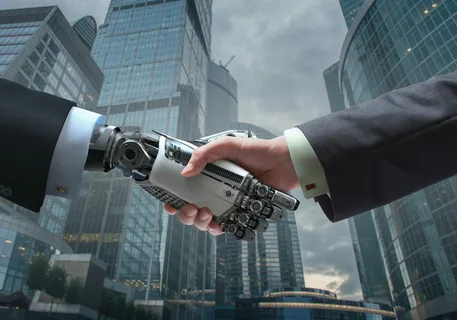
Introduction:

We have now entered the rapidly evolving field of technology, where the emergence of artificial intelligence (AI) is continues to hang large over our life like a strange shadow. Imagine this: while we wonder at AI’s capacity to revolutionize whole industries sectors and improve their operations, a terrifying truth becomes apparent. It’s a narrative with far-reaching implications that goes beyond automation replacing routine chores. Envision professions requiring specialized knowledge and human interaction, poised for significant change. Join us for an interesting voyage into the AI future, where advancement is audible and mingled with the concerning whispers of social shifts. (AI Impact On Employment & Wealth Inequality)
Job Displacement: The Dark Side of AI Advancements

With every technological advancement, there comes a cost. As AI continues to progress at an astonishing rate, the potential for job displacement is becoming a dark shadow over the workforce. It’s not just the repetitive, manual labor jobs that are at risk, but even highly skilled professions are now vulnerable to the rise of machines and hence AI impact on employment is rapidly increasing.
Imagine a world where machines can perform complex medical diagnoses with unparalleled accuracy or write sophisticated pieces of literature. While this may sound like a dream, it also raises concerns about the future of human employment. We may find ourselves in a society where human expertise is overshadowed by the efficiency and precision of AI. The fear of losing jobs and the resulting economic turmoil is a reality that cannot be overlooked. Yet, despite the apprehension surrounding this issue, there is an underlying excitement about the potential for AI to transform industries and society as a whole.
The Great Divide: Widening Wealth Inequalities in the AI Era

As we embrace the advancements of Artificial Intelligence (AI) and its promises of a more efficient and connected world, it’s crucial to confront the dark reality that accompanies this technological revolution. One of the most pressing concerns is the widening wealth inequalities in the AI era. While AI has undoubtedly contributed to economic growth and increased productivity, its benefits have not been evenly distributed among society. Instead, we are witnessing a great divide, where the gap between the haves and the have-nots continues to expand at an alarming rate.
The rise of AI has led to a concentration of wealth in the hands of a few tech giants and affluent individuals, exacerbating income disparities and leaving the majority of workers vulnerable to job displacement. The high-skilled jobs that remain in demand are often inaccessible to those without the necessary education or training, leading to a further polarization between the educated elite and the rest of the workforce. This growing divide threatens to undermine social cohesion and perpetuate systemic injustices, as those at the top reap the rewards of AI while the majority struggle to make ends meet.
Automation Takes Over: Industries Most Vulnerable to AI Job Losses
The revolution of AI is undoubtedly reshaping the way we work, and with that comes the potential for certain industries to face significant job losses. As automation takes over, some sectors are particularly vulnerable to the disruptive forces of AI. One such industry that stands at the forefront of this technological battleground is manufacturing.
With the advent of AI-powered robots and machines, manufacturing processes have become more streamlined and efficient. Tasks that were once performed by human workers are now being rapidly replaced by automated systems, causing concerns about the future of jobs in this sector. From assembly lines to packaging facilities, machines are taking over, leaving many laborers facing uncertain futures. The rapid advancement of AI in manufacturing not only threatens blue-collar jobs but also poses the risk of widening wealth inequalities as the demand for skilled labor decreases.

However, manufacturing is not the only industry that faces the ominous shadows of AI-induced job losses. Other sectors, such as transportation and logistics, are also on the frontline of this battle. With the rise of self-driving vehicles and delivery drones, the need for truck drivers and couriers may diminish, leaving many individuals in these professions struggling to find alternative employment opportunities. The digital era, once promised to bring about convenience and progress, now threatens to render some jobs obsolete, forever changing the landscape of our workforce.
Human vs. Machine: The Battle for Skilled Labor

Picture this: a bustling factory floor, once filled with skilled craftsmen meticulously operating machinery, now echoing with the mechanical hum of robots. This is the battleground where humans and machines compete for dominance in the realm of skilled labor. The rapid advancement of Artificial Intelligence (AI) has raised concerns about the future of human expertise, leaving us pondering who will emerge victorious in this epic struggle.
As we witness the rise of AI in industries that traditionally relied on human craftsmanship, it is natural to feel a sense of both awe and apprehension. On one hand, machines can perform tasks with impeccable precision, speed, and efficiency, promising greater productivity and profitability for businesses. On the other hand, the thought of our invaluable human expertise being replaced by cold, calculating machines can send shivers down our spines. Will our hard-earned skills become obsolete, or is there room for synergy between humans and machines in this battle for skilled labor?
The answer to this question lies in our ability to adapt and harness the power of AI while preserving the uniquely human qualities that make us indispensable. In order to stay relevant in an increasingly automated world, we must shift our focus from menial, repetitive tasks towards cultivating cognitive skills, creativity, and emotional intelligence. By embracing lifelong learning and reimagining our roles in the workforce, we can not only coexist with AI but also thrive in this new era of technological disruption. The battle for skilled labor is not a zero-sum game, but rather a quest for mutual empowerment and collaboration between humans and machines.
The Paradox: AI’s Potential to Boost Productivity and Profits

AI, with its remarkable capabilities, has given rise to a paradoxical situation. On one hand, it holds immense potential to revolutionize industries, enhance productivity, and increase profits. The ability of AI to analyze vast amounts of data, make complex predictions, and automate tedious tasks has left businesses and leaders excited about the possibilities. From streamlining supply chains and optimizing manufacturing processes to improving customer service and personalization, AI has sparked a wave of innovation across sectors.
Take, for example, the retail industry. By leveraging AI-powered recommendation systems, retailers can analyze customer preferences and make personalized product recommendations, leading to increased sales and customer satisfaction. In the healthcare sector, AI algorithms can assist doctors in diagnosing diseases and developing treatment plans, potentially saving lives and improving patient outcomes. Moreover, AI’s ability to automate routine tasks frees up human workers to focus on more valuable and creative work, ultimately boosting their productivity and job satisfaction. Despite the immense potential of AI to boost productivity and profits, its implications on the workforce and society as a whole cannot be overlooked.
The Winners and Losers: Who Benefits and Who Suffers?

The rise of artificial intelligence (AI) has sparked a global debate over who will be the winners and losers in this transformative era. Excitement surrounds the potential benefits that AI can bring to businesses, individuals, and societies at large. Companies that successfully harness AI technologies stand to gain a competitive edge in market innovation, productivity, and profitability. By automating repetitive tasks and streamlining complex processes, AI has the potential to revolutionize industries and create unprecedented efficiencies. As a result, businesses that embrace AI may experience significant growth and expansion, paving the way for success in the digital age.
However, the widespread adoption of AI also raises concerns about job displacement and economic inequalities. Many fear that AI advancements will lead to a significant loss of jobs, particularly in industries that heavily rely on manual labor or routine tasks. This could have a profound impact on the workforce, creating a divide between those with the necessary skills to thrive in an AI-driven economy and those left behind. Furthermore, the potential concentration of wealth and power in the hands of a few technological giants amplifies the existing wealth disparities, further exacerbating social and economic inequalities. As AI continues to reshape the future, it is crucial to examine the winners and losers in this equation and explore strategies to address the potential challenges it presents.
Bridging the Gap: Strategies for Addressing AI-Induced Inequalities

In this rapidly evolving age of Artificial Intelligence (AI), there is an imminent need to address the inequalities it may create. As the technology advances, the gap between those who benefit from AI and those who are left behind grows wider. However, with careful planning and strategic interventions, we can bridge this divide and create a more equitable future.
One key strategy for addressing AI-induced inequalities is investing in the reskilling and upskilling of workers. As jobs become automated, there will be a shift in the skills required in the workforce. By providing training programs and educational opportunities, we can empower individuals to adapt to the changing demands of the job market. This not only ensures that workers are equipped with the necessary skills but also helps to mitigate the potential job losses caused by AI advancements. Moreover, governments and organizations can work together to create policies and incentives that encourage lifelong learning and continuous development. By doing so, we can ensure that individuals are well-prepared to navigate the AI revolution.
Ethical Dilemmas: Balancing AI Progress with Social Responsibility
As the world hurtles towards a future dominated by Artificial Intelligence (AI), the question of ethical responsibility looms ever larger. Excitement over AI’s potential to revolutionize industries and streamline processes often overshadows the need to consider its impact on society at large. Balancing AI progress with social responsibility is no easy task, as companies and individuals grapple with the ethical dilemmas that arise.
One of the main concerns revolves around the potential displacement of human workers. As AI becomes increasingly sophisticated, it has the power to automate tasks previously performed by humans. While this may lead to increased efficiency and productivity, it also raises questions about job losses and the societal implications that follow. Striking a balance between embracing AI advancements and safeguarding the livelihoods of workers becomes a formidable challenge for companies and policymakers alike. How can we ensure that the benefits of AI are distributed equitably, without leaving behind those whose jobs are at stake? This ethical dilemma lies at the heart of the AI revolution, and its resolution will shape the future of our society.
Empowering the Workforce: Navigating the AI Revolution for a Better Future
The AI revolution is upon us, and while it may seem overwhelming, there is immense potential to empower the workforce and shape a better future. As technology continues to advance at an unprecedented pace, it opens doors to new opportunities and skillsets that were once unimaginable. With the right mindset and strategies in place, individuals and organizations can navigate this transformative era and harness the power of AI to their advantage.
One of the key aspects of empowering the workforce in the AI revolution lies in education and upskilling. As automation takes over routine tasks, there is a growing demand for individuals with a deep understanding of AI technologies and the ability to work alongside them. By investing in training programs and promoting lifelong learning, we can equip individuals with the necessary skills to thrive in this new era. Whether it’s through online courses, vocational training, or collaborations between academia and industry, bridging the knowledge gap will be crucial in enabling workers to adapt and seize the opportunities presented by AI. The workforce of the future must be agile, adaptable, and ready to embrace the changing landscape, for that is where true empowerment lies.
FINAL THOUGHTS:
So as you navigate this uncharted territory of the world of AI, remember that this story is not just about cool technology. It is a story with many twists and turns, and while it promises to improve the situation, it also carries the risk of job losses and widening inequality between the rich and everyone else.
The future depends on finding ways to connect the dots so that everyone has a fair chance. It would be better for us to manage ourselves and cope with technological advancements to remain ahead in this ever evolving game, if not then our game will be over. Think of this as an adventure that not only aims to advance, but also to create a future where humans matter amidst technological change.
The story of AI is still being written, and we are the ones holding the pen.
Let’s make this a story of hope, resilience, and a better world for everyone!
Unique FAQs:
How does AI impact job opportunities?
AI can both create and diminish job opportunities. While it automates certain tasks, it also opens avenues for new, more specialized roles.
Can the threat of job loss be mitigated with AI?
Yes, proactive measures such as upskilling and reskilling programs can mitigate job loss by aligning the workforce with the evolving demands of AI.
What role does humanity play in the AI narrative?
Humanity is the storyteller, making ethical choices that guide the development and deployment of AI to ensure it aligns with our collective values.
How can we ensure a fair future amidst technological changes?
Ensuring fair opportunities involves policy-making, education, and societal collaboration to address disparities and provide equitable access to AI benefits.
What steps can individuals take to navigate the challenges of AI?
Individuals can stay relevant by embracing lifelong learning, adapting skills, and actively participating in the discourse around responsible AI development.












